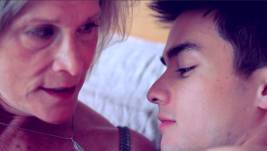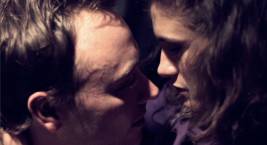NOT RECOMMENDED
When David Hare’s The Blue Room was staged at the Pasadena Playhouse in 2002, it ran about 90 minutes without an intermission. The same play now being presented at The Moth Theatre on Melrose lets out at about 10:50. Even figuring in an 8:10 start time (par for the course in 99-seat L.A. theater) and a 15 minute intermission, that’s a whopping 55 minutes longer—without adding new dialog.
Director John Markland achieves this in a variety of ways. First of all, pacing is languorous during the first act and lethally slow during Act Two. Secondly, protracted sex scenes not in Hare’s script have been added, a whopping ten of them, though too dimly lit to provoke much interest. Thirdly, between-scene set changes (nine in all) drag on and on. Still, even taking all three factors into consideration, it remains unclear where all those 55 minutes came from.
Backtracking a bit, The Blue Room is award-winning British playwright Hare’s contemporary adaptation of Austrian playwright Arthur Schnitzler’s 1900 play La Ronde, a theater work that so shocked the early 20th Century European theatrical world that it didn’t get its first public performance until 1920. Its plot—a sequence of not two or three, but ten sexual encounters. A woman meets a man, they have sex (implied, not shown), they part, the man goes on to meet and mate with another woman, who then does the same with yet another man, and so on, until the final man and the first woman have the play’s climactic (no pun intended) meeting. David Hare’s modern adaptation The Blue Room was written with just two actors in mind.
A Blue Room production earlier this year suffered from not having actors quite versatile enough to bring to life five different characters each. The Moth production’s ten actors do indeed create ten distinctive characters, and in a few cases quite well indeed. If only director Markland had respected his source material in tone, intent, and execution.
Played slow and serious, deadly serious, scenes written to be sparkling and witty end up drab and lifeless. As for Hare’s clever, tongue-in-cheek conceit of having projected slides halt each scene for a few seconds to reveal the length of each sexual encounter (e.g. “Three Minutes” for The Girl and The Cab Driver, “Nine Minutes” for The Cab Driver and The Au Pair, “Forty-five Seconds” for The Au Pair and The Student), director Markland has chosen to jettison that completely. Taking the place of these brief, occasionally comic pauses, the Moth production substitutes filmed sex scenes projected upstage as the couple in question writhes in near darkness below. As shot by projection designer Priscilla Watson, these film sequences are quite lovely and artistic, but ultimately overlong and monotonous.
A few actors survive largely unscathed. Patrick Scott Lewis is a vibrant, sexy cab driver and Scott Dunn does a winning turn as a cute, horny undergrad. Lili Bordan is such a sexy delight as the French au pair that I can’t help imagining how terrific she might be in a two-actor Blue Room. Pamela Guest does quite touching work as a bored middle-aged married woman in search of younger flesh.
As for the remaining cast (Addison Timlin as The Girl, a badly miscast and way too young James Mendoza as The Politician, Katharine Towne as The Model, the usually brilliant Justin Huen as The Playwright, Alice Fulks as The Actress, and Jan Milewicz as The Aristocrat), it’s hard to judge the level of their talents given Markland’s misguided direction. Mendoza and Towne have to compete with rapper Kanye West’s “So Appalling” in the background (“Fucking ridiculous, I mean the shit is fucking ridiculous”), making most of their scene virtually inaudible. Scenes with Huen, Fulks, and Milewicz that ought to sparkle with wit and humor are played deadly serious and deadly dull. Fulks and Milewicz’s scene in particular is virtually unrecognizable as the one written by Hare, who has good reason to request being billed as Alan Smithee in the program. (It’s one thing to Americanize a script. It’s quite another for Milewicz to vulgarize Hare’s writing with an uncountable number of “fucks.” Hare’s script contains a grand total of 10 instances of the F word doled out among numerous characters.) Finally, it seems that tattoos were a prerequisite of being cast in The Blue Room, regardless of whether the actors’ personal choices would be those of the characters they are portraying.
Benoit Guérin’s adequate scenic design reveals the production’s budget limitations, though the venetian blinds which double as a movie screen are a nice touch. Regine Linhare’s costumes are excellent choices for each character, and the between-scene song choices of Watson’s sound design have sultry, sensual feel that befits the highly sexualized nature of Markland’s concept. Jenna Pletcher’s lighting design scores high marks for variety, though the combination of dimly lit and dully played can be a deadly one at times. Melina Franks is production stage manager.
There are a few scenes in the Moth Theatre production of The Blue Room that work as playwright Hare intended them to. As for the rest, one can only imagine how they might have come across had they been played according to the script.
The Moth Theatre, 4359 Melrose Avenue, Los Angeles.
www.moththeatre.com
–Steven Stanley
December 9, 2010





 Since 2007, Steven Stanley's StageSceneLA.com has spotlighted the best in Southern California theater via reviews, interviews, and its annual StageSceneLA Scenies.
Since 2007, Steven Stanley's StageSceneLA.com has spotlighted the best in Southern California theater via reviews, interviews, and its annual StageSceneLA Scenies.







 COPYRIGHT 2024 STEVEN STANLEY :: DESIGN BY
COPYRIGHT 2024 STEVEN STANLEY :: DESIGN BY